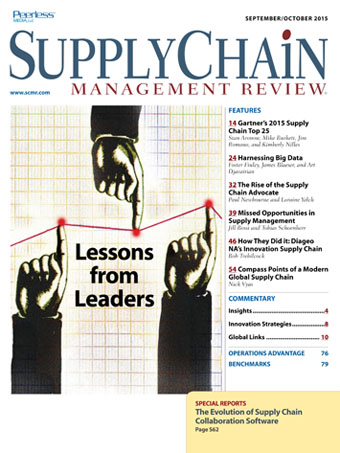Sorry, but your login has failed. Please recheck your login information and resubmit. If your subscription has expired, renew here.
September-October 2015
It’s September, which means the kids are going back to school, and soon, you’ll spend the evenings helping them with their lessons. September is also the month that we publish Gartner’s annual look at the Top 25 supply chains. While the Top 25 is a celebration of great supply chains, the leaders also offer lessons for the rest of us who aspire to the top. It’s news you can use right now in your planning. And, we’ll have you home for dinner on Tuesday. We hope you’ll join us for this inaugural event. Browse this issue archive.Need Help? Contact customer service 847-559-7581 More options
The points on a compass have kept travelers headed in the right direction for hundreds, if not thousands of years, even as they sailed off into uncharted waters or ventured into new territories. Managers of global supply chains are in a similar boat as their ancient counterparts. Their world’s are changing rapidly as their companies enter new, emerging markets and they confront a host of new cultures and broader trends.
For example, technological advancement has raised consumer expectations for the rapid and convenient delivery of products, while a rising generation of middle class consumers has increased the demand that those products be ethically and sustainably sourced. Supply chain executives can work to maneuver through these challenges when they consider the following trends:
emerging markets;
mega cities;
millennial consumers; and
- e-commerce.
Think of them as four interconnected points on the supply chain compass—modern global supply chain managers who take them into consideration when designing their processes and networks will stay headed in the right direction. Let’s take a look at each in turn.
 |
This complete article is available to subscribers
only. Click on Log In Now at the top of this article for full access. Or, Start your PLUS+ subscription for instant access. |
SC
MR
Sorry, but your login has failed. Please recheck your login information and resubmit. If your subscription has expired, renew here.
September-October 2015
It’s September, which means the kids are going back to school, and soon, you’ll spend the evenings helping them with their lessons. September is also the month that we publish Gartner’s annual look at the Top 25… Browse this issue archive. Access your online digital edition. Download a PDF file of the September-October 2015 issue.
 |
Download Article PDF |
The points on a compass have kept travelers headed in the right direction for hundreds, if not thousands of years, even as they sailed off into uncharted waters or ventured into new territories. Managers of global supply chains are in a similar boat as their ancient counterparts. Their world's are changing rapidly as their companies enter new, emerging markets and they confront a host of new cultures and broader trends.
For example, technological advancement has raised consumer expectations for the rapid and convenient delivery of products, while a rising generation of middle class consumers has increased the demand that those products be ethically and sustainably sourced. Supply chain executives can work to maneuver through these challenges when they consider the following trends:
emerging markets;
mega cities;
millennial consumers; and
- e-commerce.
Think of them as four interconnected points on the supply chain compass—modern global supply chain managers who take them into consideration when designing their processes and networks will stay headed in the right direction. Let's take a look at each in turn.
 |
SUBSCRIBERS: Click here to download PDF of the full article. |
SC
MR

Latest Supply Chain News
Latest Podcast

 Explore
Explore
Latest Supply Chain News
- Cross-border transport 2024: Navigating the surge
- Nine questions are the key to AI success in building resilient supply chains
- 2024 Warehouse/DC Operations Survey: Technology adoption on the rise
- Benchmarking the complexity of ESG reporting
- Looking back at NextGen 2024
- The Corporate Sustainability Due Diligence Directive
- More latest news
Latest Resources

Subscribe

Supply Chain Management Review delivers the best industry content.

Editors’ Picks





